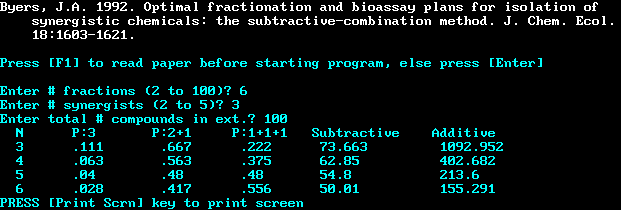Byers, J.A. 1992. Optimal fractionation and bioassay
plans for isolation of synergistic chemicals:
the subtractive-combination method.
Journal of Chemical Ecology 18:1603-1621.

the above are results of program SUBTRACT.EXE, where column "N" has the
number of initial fractions (3, 4, 5, or 6), column P:3 has the probabilities for all
3 synergists being in one fraction (based on N fractions and 3 synergists); column P:2+1
has the probabilities for 2 synergists being in one fraction and the third synergist being
in any other fraction; column P:1+1+1 has the probabilities of all 3 synergists being in
different fractions (this probability is higher with more fractions). The "Subtractive" column
indicates how many bioassay tests would be expected to ensure isolation of all synergists using the
initial fractionation plus a second fractionation (where each fraction is divided into the number of fractions equal to the
number of compounds in that fraction) using the subtractive-combination method. It is apparent that
that the "Additive" method (where all combinations of fractions are tested) requires many more tests to ensure isolation
of synergists and therefore the additive-combination method is not as efficient.
Abstract--
Studies of chemical ecology of an organism are founded on the isolation and
identification of a semiochemical, often comprised of two or more synergistic
compounds (each synergist alone has little activity, but presented together
they are bioactive). Chromatographic fractionation and bioassay methods of
binary splitting, additive-combination, and subtractive-combination are
compared for efficiency in isolating synergists. Formulas are derived for the
latter two methods that calculate the expected number of bioassay tests
required for isolation of from two to five synergists from biological extracts
with any number of compounds, depending on the number of initial (major)
chromatographic fractions. A computer program based on the formulas
demonstrates the superiority of the subtractive-combination method. Simulations
with the program were used to determine the optimal number of initial fractions
for the additive- and subtractive-combination methods when isolating two to
five synergists from extracts of from 25 to 1200 compounds. Methods of
bioassay, isolation, identification, and field testing of semiochemicals are
discussed.
 Download software: SUBTRACT.ZIP
Download software: SUBTRACT.ZIP
 Chemical Ecology
Chemical Ecology


 Download software: SUBTRACT.ZIP
Download software: SUBTRACT.ZIP
 Chemical Ecology
Chemical Ecology